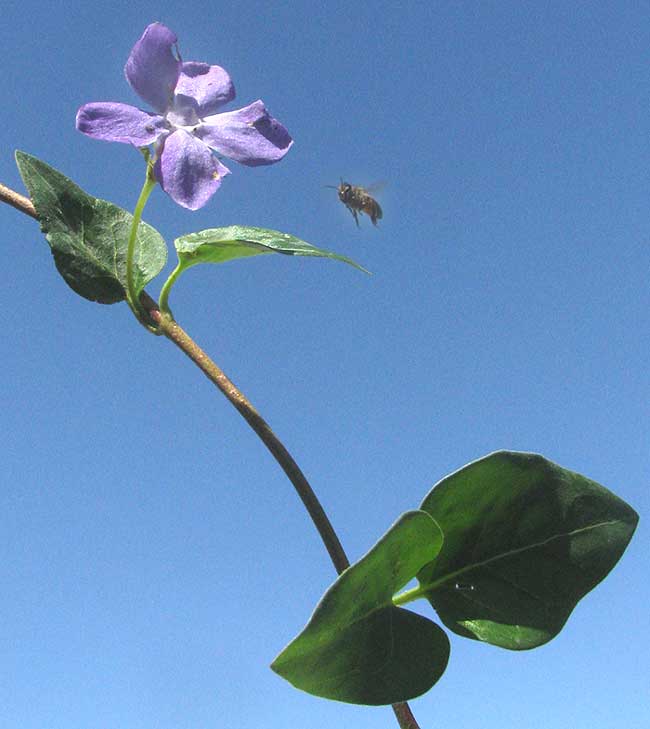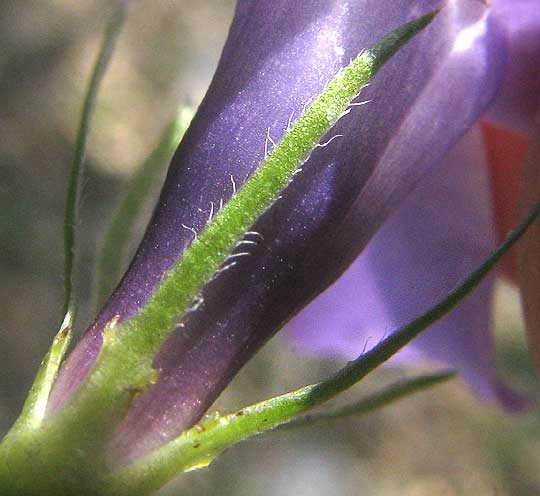Excerpts from Jim Conrad's
Naturalist Newsletter

from the March 17, 2013 Newsletter issued from the valley of the Dry Frio River in northern Uvalde County, southwestern Texas, on the southern border of the Edwards Plateau; elevation ~1750m (~5750 ft); N29.62°, W99.86°; USA
PERIWINKLE FLOWERING
Upon my arrival here last August my first task was to clear periwinkle vines from flower beds next to the cabin. The periwinkles formed a pretty, green carpet on the ground but the vines climbed the cabin's walls, wedging themselves beneath loose-fitting boards and seeming to pry certain boards apart, and even snaking between boards into the porch, where they sprawled across the floor and climbed up screens. Though I cleaned every visible sprig from the beds, periwinkle stems can root and sprout at their nodes, so before long every stem segment left behind beneath a rock or the flower beds' timbers produced a robust new plant issuing welcome greenery all through the winter. This week some of the sprouts flowered. Knowing the cabin owner would want all the periwinkle uprooted again, I broke off a piece with its purple blossom and held it against the blue sky, creating the image shown at the top of this page.
In North America we have two common periwinkle species, Vinca minor and Vinca major. This is VINCA MAJOR, sometimes distinguished from the other species by the names Bigleaf Periwinkle, Greater Periwinkle, and the like. If the two periwinkle species are seen side-by-side it's easy to distinguish them, for leaves of Vinca minor are relatively narrower and only 0.8 to 1.8 inches long (2 to 4.5 cm), while leaves of our Vinca major are heart-shaped to triangular, and 1.5 to 2.5 inches long (4 to 6 cm). However, in the field you see lots of variation and overlapping of features, so it's not always easy to distinguish them. A little trick proving that you have our Bigleaf Periwinkle, Vinca major, is shown below:

Those are a Bigleaf Periwinkle flower's slender sepals -- the green, cuplike calyx divisions below the corolla -- and their margins are hairy. Sepal margins of Vinca minor are hairless.
Both common periwinkle species are invasive introductions from Eurasia. They're members of the big Dogbane Family, the Apocynaceae, a family famous for its species containing powerful chemicals with medicinal and toxic properties. Therefore it's no surprise that every part of the periwinkle contains low levels of alkaloids that, if eaten in large enough quantities, can be harmful to dogs, cats, horses and humans. Symptoms include abdominal cramps, vomiting, diarrhea, a drop in blood pressure, lethargy and/or tremors or seizures. Larger doses induce coma or even death.
But, this is a handsome species, and I'm grateful to it for its purple blossoms here so early in spring. I appreciate the greenness it has provided all winter and I even admire its lusty persistence. I'll pull it all out, though, because it seems intent on tearing the old cabin's walls apart, and in claiming all the flower-garden space for itself. Besides, it's clear that it'll reassert its claim to this land as soon as I leave. I suspect that someday long after the last human has disappeared from this community, the entire neighborhood may become carpeted in dark green periwinkle vine only here and there with a sprig of Big Bluestem rising above the carpet.